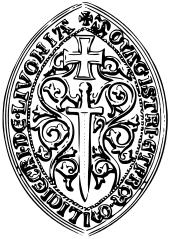  Seal of the Livonian Brothers of Sword, medieval Livonia; text: ILIDIECRI•DE•LIVONIA+*****ISTRI•*T*R** Date: 13th century Source: History of Estonia, 2007, ISBN: 9789985209303 |
TEUTONIC KNIGHT IN HABIT, 13th CENTURY
An extract from Armies of Feudal Europe 1066-1300by Ian Heath
